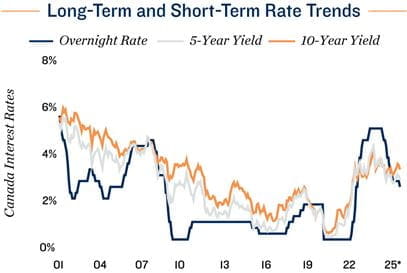Research Brief
Canada Monetary Policy
September 2025

Second Rate Cut in 2025 Aids Market
Fundamentals and Fuels Liquidity for Buyers
BoC cuts rate as expected in September. In line with market expectations, the Bank of Canada lowered the overnight rate by 25 basis points at its September policy meeting, bringing it to 2.5 per cent. Since its July meeting, Canada’s labour market has weakened. A loss of nearly 110,000 jobs between July and August pushed the unemployment rate up to 7.1 per cent. On the price front, despite some mixed signals, recent inflation data suggest that upwards price pressures have eased, even with higher costs from trade disruptions. Additionally, the risk of future inflation has diminished, as Canada has removed most of its retaliatory tariffs on U.S. goods. Together, these three developments have shifted the balance of risks, prompting the BoC to resume rate cuts since its March policy move
Central Bank stays guarded as uncertainties persist. Despite the rate reduction, the BoC provided little clear guidance on its plans for future policy meetings. It also removed from its July announcement the statement indicating a potential need for future reductions if warranted by weakening economic data and contained trade disruptions. With Canada-U.S. trade negotiations stalled, the Bank is likely to proceed cautiously, taking one step at a time as it monitors how economic activity evolves under higher U.S. tariffs, as well as how prices respond to trade disruptions and supply chain adjustments. Nevertheless, if the drag on Canada’s economy persists alongside easing inflationary pressures, the Bank is expected to cut rates further before year-end.
Commercial Real Estate Outlook
Rate cuts provide lift across property sectors. In the retail sector, fundamentals have remained solid despite economic headwinds. Household spending has proven resilient, with consumers drawing on savings as unemployment rises. Lower interest rates should help sustain this consumption momentum, though slower population growth is expected to increasingly weigh on total spending growth going forwards. A resilient retail sector will also provide a backstop for leasing activity in the industrial sector, which has faced softer demand from large logistics, transportation and warehousing firms amid trade-related risks. At the same time, lower borrowing costs will support business expansion, particularly in the tech, finance, real estate and insurance industries – key drivers of office demand. As a result, the ongoing recovery in the office sector is expected to gather further strength, reinforcing absorption trends and exerting continued downwards pressure on vacancy rates.
Falling rates boost investment prospects. Alongside the BoC’s action, the Federal Reserve also cut interest rates by 25 basis points on the same day, with its latest projections signalling two additional reductions by year-end. This parallel move is expected to ease borrowing costs across the yield curve. In particular, long-term rates – such as 5-year and 10-year government bond yields – may see meaningful declines after remaining elevated over the past year. Amid persistent uncertainties, sectors better insulated from trade disruption are likely to benefit most from renewed buyer interest, supported by these improved financial conditions.


* Through September; ** Through 2Q; ^ Trailing 12-month average
Sources: Marcus & Millichap Research Services; Altus Data Solutions; Bank of Canada; Federal
Reserve; Statistics Canada
TO READ THE FULL ARTICLE
